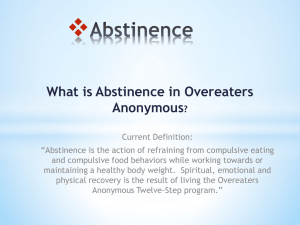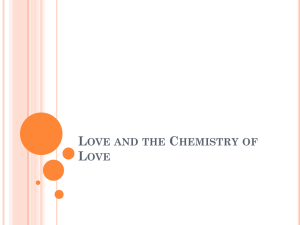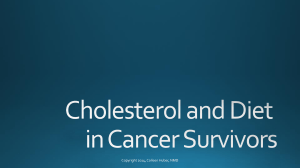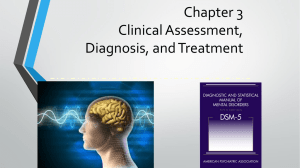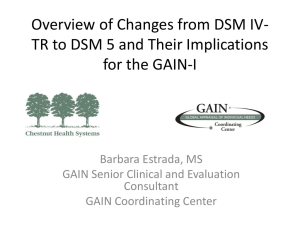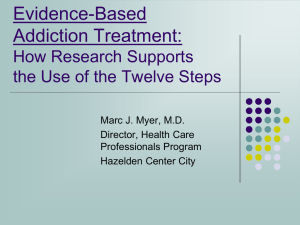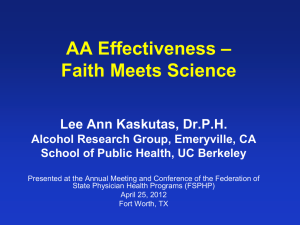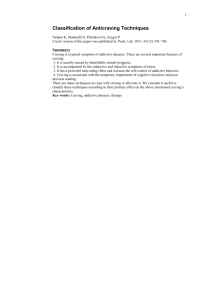SUBSTANCE DEPENDENCE
advertisement
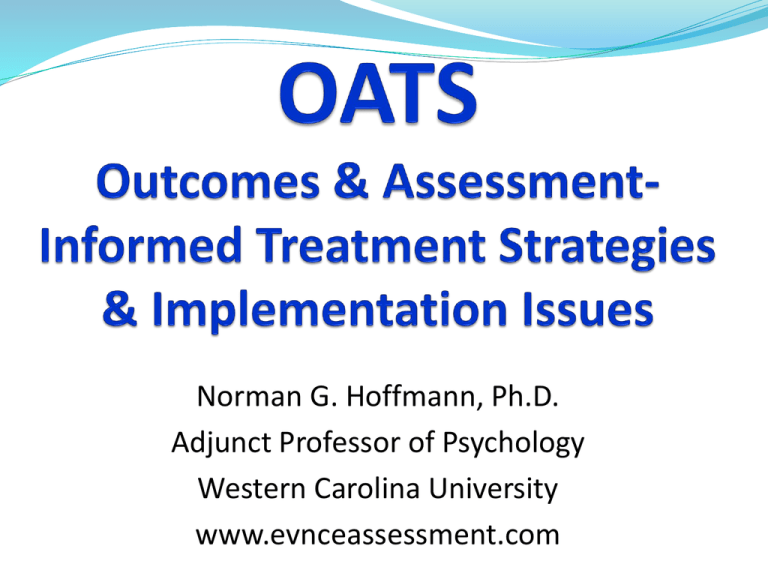
Norman G. Hoffmann, Ph.D. Adjunct Professor of Psychology Western Carolina University www.evnceassessment.com Evidence-Based Treatment Utilize a treatment model documented to be effective in controlled clinical research Question of whether the model is implemented with fidelity No guarantees that it will work in routine clinical practice even if implemented properly No verification of outcomes Assessment-Informed Treatment Assessment documents nature and severity of conditions and initial differential treatment needs During treatment integrate assessment data with treatment response to document progress and identify risk and resiliency variables Use findings to adjust treatment plan and refine future assessment and treatment decisions Develop empirically justified foundation for determining medical/clinical necessity Outcomes-Informed Treatment Monitor baseline and initial relevant outcomes for all clients – outcomes can be clinical and/or societal/financial Monitoring done during typical continuum of care (e.g., during maintenance services) Uses information already required for quality care – store in useable format Retrieval of data for analyses Document medical/clinical necessity Potential Uses for Outcomes Documentation Identify Differential Treatment Needs Identifying Differential Relapse Risk Empirically Derived Medical Necessity Enhancing Client Motivation Treatment Improvement Marketing Services Justifying Treatment Costs - ROI Public Relations Assessments Identify Differential Treatment Needs and Relapse Risk Substance Use Disorder Criteria 1.Use in larger amounts or longer than intended 2. Desire or unsuccessful effort to cut down 3. Great deal of time using or recovering 4. Craving or strong urge to use 5. Role obligation failure 6. Continued use despite social/interpersonal problems 7. Sacrificing activities to use or because of use 8. Use in situations where it is hazardous DSM-5 SUD Criteria continued 9. Continued use despite knowledge of having a physical or psychological problem caused or exacerbated by use 10.Tolerance 11. Withdrawal Criteria 1-4 relate to use; Criteria 5-8 relate to behavioral issues associated with use; Criteria 9-11 relate to physical/emotional issues DSM-5 Initial VS. DSM-5 Final Initially the proposed DSM-5 had two diagnostic categories: moderate and severe defined by 2-3 and 4+ positive criteria – conforms best to abuse – dependence classification Final formulation has three categories: mild (2-3), moderate (4-5), and severe (6+ positive criteria) Original “moderate” becomes “mild” – no empirical foundation for either distinction Sustained Remission No positive diagnostic findings (other than craving) for 12 consecutive months Substance use is NOT part of the remission definition Possible levels of outcome: 1) abstinence without problems; 2) some use without problems; 3) use with sub-diagnostic problems; 4) meets current diagnosis You get paid for remission NOT recovery DSM-5 Criteria Differentials All criteria are not equal in implications Some criteria are found predominately among those with the severe alcohol or other substance use disorder diagnoses Other criteria are more common among the mild to moderate alcohol use disorder group Tolerance and dangerous use are actually common among those with no diagnosis SUD CRITERIA PRIMARILY IN SEVERE DESIGNATION The “Big Five” Criteria 2:Wanting to cut down/setting rules Criteria 4: Craving and/or compulsion to use Criteria 5: Failure at role fulfillment due to use Criteria 7: Sacrifice activities to use Criteria 11: Withdrawal symptoms Sample of Alcohol Diagnostic Documentation Alcohol Diagnosis Case 1 Case 2 Case 3 Case 4 Diagnostic Criteria 1 2 3 4 Severe Mild X X X X X X Moderate Moderate X X X X 5 6 7 8 X X 9 10 11 X X X X X X X X Cases 3 & 4 with the same diagnosis may have different prognoses if the Big Five are related to outcomes X CASE 3: Positive DSM-5 Criteria 3. Great deal of time using 10. Tolerance 1. Unplanned use: more or longer use 8. Use in hazardous situation (impaired driving) 6. Recurrent interpersonal conflicts Conclusions No loss of control indicated Misuse and possible irresponsible behavior Moderation may be a reasonable initial goal CASE 4: Positive DSM-5 Criteria 1. Unplanned use: more or longer use 2. Desire/efforts to cut down 4. Craving/compulsion to use 5. Role obligation failures 7. Sacrificing activities to use Conclusions Loss of control clearly indicated Positive on 4 of the “Big Five” Abstinence indicated goal for recovery Implications for Disposition Education and brief counseling may be appropriate for majority of mild use disorders For those with a moderate diagnosis, the pattern may be as important as the number of positive criteria Those positive on any of the Big Five criteria should be carefully evaluated regarding the current and projected trajectory of their condition Final Criticism of the DSM-IV Loss of control not required for a dependence diagnosis – e.g., tolerance, spending time using, and occasionally drinking more/longer than intended – got the chronic diagnosis Some abuse criteria are stronger indications of a serious condition than some dependence criteria Role obligation failure is a Big Five criterion Tolerance is often seen in mild cases or even among those with no diagnosis CLINICAL (Medical) NECESSITY Persons in the severe designation with positive “Big Five” findings will require a more intensive and longer continuum of care to achieved treatment effectiveness Persons in the mild designation typically will benefit from shorter & less intensive interventions to achieve efficiency Each treatment plan can be informed by prior empirical outcome data on comparable cases and modified based on the individual’s treatment response Sample Hypotheses for Clinical Practice Hypothesis #1: Clients positive on three or more of the “big five” will require initial residential placement and/or more intensive and longer continuum of care to achieve good results Hypothesis #2: Clients in mild or moderate designations without any positive findings on the “big five” may be able to moderate or stop use with less intensive and briefer services Beware of Arbitrary Outcome Metrics Scientifically reliable and valid Irrelevant to the real world Reference on arbitrary metrics: Kazdin, A. E. (2006). American Psychologist, 61(1), 42-79. Addiction Treatment Examples: Average days of use in past 30 days Scores on a variety of psychological instruments Arbitrary Metric Example Programs A and B each treat 100 cases Program A: Before treatment average days of use = 25 After treatment average days of use = 10 Program B: Before treatment average days of use = 25 After treatment average days of use = 8 Which program has the better outcomes? Arbitrary Metric Example Real world results: Program A: 60 in full remission; 40 minimal change Program B: Zero remission: All 100 still using just on weekends, but all have continuing problems and meet current criteria for severe SUD (dependence) To which program would you refer a family member? Demographic Risk Scale Less than 25 years of age. No high school diploma or GED. Unemployed. Never married. Three or more positive characteristics increases expected relapse rate by about 20% or more Demographic Risk Scale and Observed Outcomes Abstinence Months 7-12 80% 70% 60% Subthreshold 50% Threshold + 40% 30% 20% 10% 0% High Risk Low Risk 35 Unites of service = threshold for low risk group 75 Unites of service = threshold for high risk group Zywiak, Hoffmann, & Floyd, 1999 Client Motivation and Empowerment Maintenance Care Thresholds N = 12,783 Treatment Completers 73% % Abstinent at One Year 80% 70% 60% 60% 53% 0-2 months 50% 3- months 40% 5-6 months 30% 20% Months of Maintenance Care (Aftercare) Hoffmann & DeHart (1996). CATOR Fact Sheet One Year Abstinence Rates for Older Alcohol Dependent Clients 90 % of Cases 80 High Severity 70 60 Low Severity 50 40 30 No Main. & No AA Main. No AA AA No Main. Main. & AA Combinations of 4+ months of Maintenance Care and/or Weekly AA Attendance for 1,350 treatment completers Hoffmann, DeHart & Gogineni (1998). The Southwest Journal on Aging, 14(1), 57-64. Additional Data Required for Differential Outcome Example CONTINUED CARE & SELF-HELP GROUPS Rate attendance using the scale: 1 = never/stopped 3 = Several times a mo. 2 = Once a month or less 4 = At least once a week How often did you attend the following during the past three months: 09. Formal aftercare 10. AA 11. NA 12. Other support group ____ ____ ____ ____ Treatment Improvement CLINICAL CONTINUOUS IMPROVEMENT COMPONENTS Patient Assessment Intake and ongoing assessments Outcomes Treatment Plan Initial clinical outcomes Remission outcome Societal benefit measures Financial benefit measures Define problems Treatment priorities Treatment placement Treatment Response/Progress Biopsychosocial treatment Process measurements Adjustments to treatment plan as needed TREATMENT RATINGS [asked by follow-up interviewer] Rate how helpful the following treatment components have been for your recovery? 0 = not used 1 = poor; 2 = fair; 3 = good; 01. Group Therapy 02. Individual counseling 03. Lectures & education 04. Working the AA/NA steps 05. Peer-group meetings (e.g., AA) 06. Family portion of program 07. Talking with other clients 08. Overall rating for the program 4 = excellent ____ ____ ____ ____ ____ ____ ____ ____ Feedback on Helpfulness of Program Components Helpfulness in remission – not satisfaction with the component Low scores indicate opportunities for improvement High scores indicate potential areas of excellence Requirements for Clinical Outcomes Monitoring System Capture demographic and descriptive information to describe the population Document clinical information in sufficient detail to facilitate treatment refinement Document response to the treatment services delivered Document outcomes during typical continuum of care Specialty Studies for Identifying Problem Issues Pavillon Study of Trauma, Distress, and Craving Evaluation of potential problems and relapse risks Distress measure (DARNU), PTSD symptom count, and validated craving measures for alcohol and drugs Explore the possibility of identifying level of distress and trauma relative to craving Trauma, Distress, and Craving DARNU: D – Dissatisfied A – Anxious R – Restless N – Nervous U – Uncomfortable 18- item self-report scale DARNU correlates highly with PTSD (r = .78) and craving (r = .36) Implications: 1. DARNU can identify probable PTSD 2. Warning indication for greater craving Distress (DARNU) and PTSD 100% 80% PTSD Dx 60% Possible 40% No DX 20% 0% Quartile 1 Quartile 2 Quartile 3 Quartile 4 DARNU elevation quartiles N = 124 Justifying Investment in Treatment ROI: RETURN ON INVESTMENT The good news: ROI for addictions treatment is one of the largest in healthcare: between 4:1 to 7:1 Returns accrue to society in areas outside of healthcare The bad news: ROI within healthcare is a fraction of returns and may not pay for all treatment needs Other areas that benefit do not traditionally pay for clinical services Healthcare Returns: Proportional to Effectiveness Average Days of Hospitalization 4 3.5 Before Tx 3 2.5 Year 1 2 Year 2 1.5 Relapse vs. Recovery 1 Before Tx p = N.S. 0.5 Yr 1 & Yr 2 p < .001 0 Relapsed n = 1473 Recovering n = 2099 Hoffmann, DeHart, & Fulkerson (1993). Journal of addictive Disease, 12(1), 97-107. Public Safety Issues by Diagnosis N = 7,682 state prison inmates Percent of sample 60 50 40 30 No Dx Abuse Depend. 20 10 0 DU Arrest MV Crash Drove Impaired 3 times Highway Safety Returns: Proportional to Effectiveness Motor Vehicle Accidents 30% % of Cases 25% Relapsed n = 3,153 21% 22% 20% 20% 15% 12% Partial Abstinence n = 3,425 10% 7% 10% 5% 0% Before Treatment After Treatment Hoffmann & DeHart (1996). CATOR Report. Abstinent n = 9,326 Criminal Justice Returns: Proportional to Effectiveness Proportion of Cases Arrested 30% Relapsed n = 3,153 % of Cases 25% 20% 15% 16% 16% 11% 10% Partial Abstinence n = 3,425 9% Abstinent n = 9,326 6% 2% 5% 0% Before Treatment After Treatment Hoffmann & DeHart (1996). CATOR Report. Healthcare Returns On Investment for Dependent Employees Before After Treatment Treatment Employees Hospitalized 24% 10% Employees Using ER 29% 21% Total Days of Hospitalization 7639 5158 Vocational Functioning Returns On Investment Problem types include: absenteeism, tardiness mistakes, lack of work completion, conflicts, and on the job injuries Number of Problem Types None Before Treatment 35% After Treatment 76% One 23% 16% Two 18% 5% Three 11% 2% Four plus 13% 1% Medicare/Medicaid Funded Treatment and Recovery 37% 40% % of Cases 35% 31% 30% 25% 26% Relapsed n = 378 21% 20% Abstinent n = 364 15% 10% 5% 0% Hospitalizations ER Visits Hoffmann (1994). Report for George Washington University Significance p < .001 Medicare/Medicaid Funded Treatment and Recovery % of Cases 20% 15% Relapsed n = 378 13% 10% 10% 5% Abstinent n = 364 3% 2% 0% Auto Accidents Arrests Hoffmann (1994). Report for George Washington University Significance p < .0001 Marketing Marketing to Whom? Potential clients and/or families of those affected Employers with stable workforces consisting of employees who are difficult or expensive to replace Public officials tasked with stretching limited budgets Insurers – FOR GET IT Personalized Marketing Points The probability of a positive outcome for severe substance use disorders is as good as other chronic conditions Recovery (or remission) is largely determined by client adherence to a realistic recovery plan Some ongoing services may be required as is the case with other chronic conditions Support systems exist for both the afflicted and their families General Marketing Points The probability of a positive outcome for severe substance use disorders is as good as other chronic conditions Treatment for substance use disorders is comparatively inexpensive to those for other chronic conditions Benefits from treatment services accrue not only to the person treated, but also to society at large Public Relations Public Relations Errors Many people concerned about addictions: Talk to the wrong people About the wrong topics Using the wrong terminology And wonder why nothing changes The Lesson of the Peacock The peacock is among the most beautiful of birds. However, its “song” is among the most awful of sounds. Trying to teach a peacock to sing is a waste of time and neglects the beauty – focuses on weakness not strength Voice of the Peacock An alcohol or drug dependent person does not make an attractive poster child – biased perspectives – stigma. Failures are very obvious and visible. Successes tend to disappear from view. The general public does not care whether dependent people recover. Beauty of the Peacock Return on investment is one of the greatest in the healthcare arena. Reasonable recovery rates relative to other chronic illnesses can be documented. Treatment costs are modest compared to other areas of healthcare. Benefits of treatment are found throughout society Who Cares About What? The general public cares about safety and financial issues Employers care about turnover and performance Public officials want to support positions that will get them reelected The media look for a good story that will get attention Relationships with the General Population The general public cares about safety and financial issues Most people are not concerned about the welfare of addicted individuals Most people do not have a realistic understanding of addictions or treatment Relationships with Employers Focus on employers with stable workforces and where employees are difficult or expensive to replace Make the case that recovering employees make excellent workers Educate them that afflicted workers can be identified and treated successfully Relationships With Elected Officials Most elected officials have no realistic understanding of addictions or treatment Most are interested in the general welfare To do what is right, some will need political cover to support treatment vs. punitive strategies Relationships With the Media Reporters are always looking for a good story – either good or bad news Combining a personal recovery story with outcome data can be a powerful positive story A little controversy can be a positive thing if you select the controversy Norman G. Hoffmann, Ph.D. Adjunct Professor of Psychology Western Carolina University evinceassessment@aol.com 828-454-9960 www.evinceassessment.com

